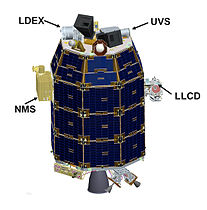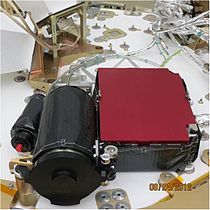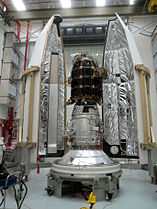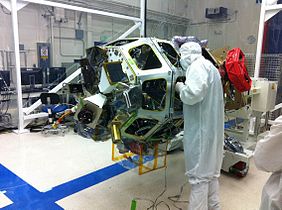LADEE
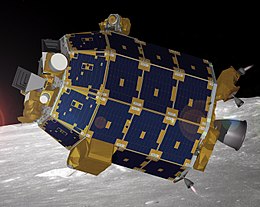 Artist's depiction of LADEE in lunar orbit | |
| Mission type | Lunar atmospheric research |
|---|---|
| Operator | NASA |
| COSPAR ID | 2013-047A |
| SATCAT no. | 39246 |
| Website | LADEE Mission at NASA.gov |
| Mission duration | 100 days (planned) |
| Spacecraft properties | |
| Bus | MCSB |
| Manufacturer | Ames Research Center |
| Launch mass | 383 kg (844 lb)[1] |
| Dry mass | 248 kg (547 lb)[1] |
| Power | 295 watts at 1 AU[1][2] |
| Start of mission | |
| Launch date | September 7, 2013, 03:27 UTC[3] |
| Rocket | Minotaur V |
| Launch site | MARS LP-0B |
| Contractor | Orbital Sciences Corporation[2] |
| Orbital parameters | |
| Reference system | Geocentric (until c. Oct 6, 2013, when it will enter a selenocentric orbit)[1] |
| Periselene altitude | 20 km (12 mi) during science phase[2] |
| Aposelene altitude | 60 km (37 mi) during science phase[2] |
| Period | ~114 minutes during science phase[2] |
| Lunar orbiter | |
| Orbital insertion | October 6, 2013, 10:57 UTC |
The Lunar Atmosphere and Dust Environment Explorer (LADEE) is a NASA lunar exploration mission led by Ames Research Center in collaboration with Goddard Space Flight Center. It was launched on a Minotaur V from the Mid-Atlantic Regional Spaceport on September 7, 2013, at 03:27 UTC.[4] During its nominal 100-day scientific mission, LADEE will orbit around the Moon's equator, and use instruments aboard the spacecraft to study the lunar exosphere and dust in the Moon's vicinity. Instruments include a dust detector, a neutral mass spectrometer, and an ultraviolet-visible spectrometer, as well as a technology demonstration consisting of a laser communications terminal.[5] (see Free-space optical communication "lasercom")
History
LADEE was announced during the presentation of NASA's FY09 budget in February 2008.[citation needed] It was initially planned to be launched with the Gravity Recovery and Interior Laboratory (GRAIL) satellites.[6] The full-scale thermal vacuum chamber testing was performed at NASA's Ames Research Center in April 2013. Previous mechanical tests—including acoustic, vibration and shock—were completed prior to the thermal-vacuum testing.[7] During August 2013, LADEE underwent final balancing, fuelling and mounting on the launcher, and all pre-launch activities were complete by August 31, ready for the launch window which opened on September 6.[8]
NASA Ames is responsible for the day-to-day functions of LADEE while the Goddard Space Flight Center operates the sensor suite and technology demonstration payloads as well as managing launch operations.[9] The LADEE mission totals approximately $280 million, which includes spacecraft development and science instruments, launch services, mission operations, science processing and relay support.[2]
Atmospheric glow

There is some evidence that the Moon may have a tenuous atmosphere of moving particles constantly leaping up from and falling back to the Moon's surface, giving rise to a "dust atmosphere" that looks static but is composed of dust particles in constant motion. According to models proposed starting from 1956,[11] on the daylit side of the Moon, solar ultraviolet and X-ray radiation is energetic enough to knock electrons out of atoms and molecules in the lunar soil. Positive charges build up until the tiniest particles of lunar dust (measuring 1 micrometre and smaller) are repelled from the surface and lofted anywhere from metres to kilometres high, with the smallest particles reaching the highest altitudes.[12][13][11][14] Eventually they fall back toward the surface where the process is repeated. On the night side, the dust is negatively charged by electrons in the solar wind. Indeed, the "fountain model" suggests that the night side would charge up to higher voltages than the day side, possibly launching dust particles to higher velocities and altitudes.[12] This effect could be further enhanced during the portion of the Moon's orbit where it passes through Earth's magnetotail;[15] see Magnetic field of the Moon for more detail. On the terminator there could be significant horizontal electric fields forming between the day and night areas, resulting in horizontal dust transport.[15]
Also, the Moon has been shown to have a "sodium tail" too faint to be detected by the human eye. It is hundreds of thousands of miles long, and was discovered in 1998 as a result of Boston University scientists observing the Leonid meteor storm. The Moon is constantly releasing atomic sodium gas from its surface, and solar radiation pressure accelerates the sodium atoms in the anti-sunward direction, forming an elongated tail which points away from the Sun.[16][17][18] It is to be determined if ionized sodium gas atoms or charged dust are the cause of the reported Moon glows.[19]
Mission objectives
LADEE mission will address three major science goals:[20]
- Determine the global density, composition, and time variability of the tenuous lunar exosphere before it is perturbed by further human activity.
- Determine if the Apollo astronaut sightings of diffuse emission at tens of kilometers above the surface were sodium glow or dust.
- Document the dust impactor environment (size-frequency) to help guide design engineering for the outpost and also future robotic missions.
Spaceflight operations


Launch
LADEE was launched on September 7, 2013, at 03:27 UTC (September 6, 11:27 p.m. EDT) out of the Wallops Flight Facility at the Mid-Atlantic Regional Spaceport on a Minotaur V carrier rocket.[21] This was the first lunar mission to be launched from that facility. The launch had the potential for visibility along much of the U.S. eastern seaboard, from Maine to South Carolina.[22]
As the Minotaur V is a solid-propellant rocket, spacecraft attitude control on this mission operated a bit differently than on a typical liquid-fueled rocket with more continuous closed-loop feedback. The first three Minotaur stages "fly a pre-programmed attitude profile" to gain velocity and deliver the vehicle to its preliminary trajectory, while the fourth stage is used to modify the flight profile and deliver the LADEE spacecraft into perigee for the spin-stabilized fifth stage to then put the spacecraft into a highly-elliptical orbit around Earth—the first of three—to begin a month-long Lunar transit.[23]
While now separated from the LADEE spacecraft, both the fourth and fifth stages of the Minotaur V reached orbit, and are now space debris in Earth orbit.[1]
Lunar transit
LADEE took an unusual approach in its transit of the Moon. Launched into a highly elliptical Earth orbit, the spacecraft made three increasingly-larger laps around Earth[1] before getting close enough to enter into Lunar orbit. The transit required approximately one month.[24]
After separating from the Minotaur, high electrical currents were detected in the satellite's reaction wheels causing them to be shut down. There was no indication of a fault, and after the protection limits were adjusted orientation with reaction wheels was resumed the following day.[25]
The LADEE spacecraft made three "phasing orbits" of Earth before it accomplished a Lunar orbit insertion (LOI), which occurred at perigee of the third orbit using a three-minute engine burn.[1] The target orbit for the third Earth orbit had a perigee of 200 kilometers (120 mi), an apogee of 278,000 km (173,000 mi) and an inclination of 37.65 degrees. The planned argument of perigee is 155 degrees, while its characteristic energy, C3 is -2.75 km2/s2.[1]
The novel trajectory using orbital phasing loops was done for four main reasons:[26]
- the Minotaur V launch vehicle had insufficient delta-v to put the 383 kg (844 lb) LADEE directly into a trans-lunar injection.
- to handle potential off-nominal launch dispersions from the Minotaur V— which is a stack of five solid rocket stages, and is not considered to be a particularly precise rocket —in a propellant-efficient manner while leaving the orbit profile flexible to large dispersions in the initial injection orbit.
- to widen the launch window to five days. In the event, LADEE did not need this as the launch occurred at the beginning of the window on the first day.
- to increase mission robustness in the face of any anomalous or missed orbital maneuvers with the spacecraft.
Lunar orbit and systems checkout

LADEE entered lunar orbit on October 7, 2013, when LADEE was put into an elliptical capture orbit of 24 hours duration.[27] LADEE was further lowered into a four-hour orbit on October 9, 2013,[28] One further burn occurred on October 12 lowering LADEE into a circular orbit around the Moon with an altitude of approximately 250 kilometers (160 mi) for its commissioning phase, which will last about 30 days.[29] LADEE's systems and instruments are planned to be checked out when the orbit is lowered to 75 km (47 mi) altitude.[1]
Lunar Laser Communication Demonstration
LADEE successfully sent data between the spacecraft and its station on the Earth on October 18, 2013 using a laser, at a distance of about 239,000 miles (384, 633.2 km)..[30]
The data returned from the Lunar Laser Communication Demonstration (LLCD) set a space communication bandwidth record in October 2013 when early tests using a pulsed laser beam to transmit data over the 385,000 km (239,000 mi) between the Moon and Earth passed data at a "record-breaking download rate of 622 megabits per second (Mbps)",[31] and also demonstrated an error-free data upload rate of 20 Mbps from an Earth ground station to LADEE in Lunar orbit. The LLCD is NASA's first attempt at two-way space communication using an optical laser instead of radio waves, and is expected to lead to operational laser systems on future NASA satellites in future years.[31]
Science phase
For the science operations, LADEE will be maneuvered into an orbit with a periselene of 20 km (12 mi) and an aposelene of 60 km (37 mi).[2] The science phase of LADEE’s primary mission is expected to last 100 days.[1]
Spacecraft
Design
LADEE is the first spacecraft ever designed, integrated, built, and tested by NASA's Ames Research Center.[32] The spacecraft is of a novel design (a spacecraft bus never previously flown)—and of much lower cost than typical NASA science missions—which presented novel challenges to the trajectory design team in getting the new spacecraft launched to the Moon with a high-confidence spaceflight trajectory plan, while dealing with a first-use new rocket (Minotaur V) and a spacecraft with no flight test legacy. (see Lunar transit, below.)[32] LADEE mission makes use of the Modular Common Spacecraft Bus, or body, that has the ability to perform on various kinds of missions - including voyages to the Moon and Near Earth Objects - with different modules or applicable systems. This modular concept is an innovative way of transitioning away from custom designs and toward multi-use designs and assembly-line production, which could drastically reduce the cost of spacecraft development.[33] The LADEE spacecraft bus modules consist of the Radiator Module, that carries the avionics, electrical system, and attitude sensors; the Bus Module; the Payload Module that carries the two largest instruments, and the Extension Modules, which house the propulsion system.[2]
- Specifications
The main structure is 2.37 m (7.8 ft) high, 1.85 m (6.1 ft) wide and 1.85 m (6.1 ft) deep. The total mass of the spacecraft is 383 kg (844 lb).[2]
Power
Electric power is generated by a photovoltaic system composed of 30 panels of silicon solar cells producing 295 W at one AU. The solar panels are mounted on the satellite's exterior surfaces and the electrical power is stored in one lithium-ion battery providing up to 24 amp-hours of 28-volt power.[2]
Propulsion system
The LADEE propulsion system consists of an orbit control system (OCS) and a reaction control system (RCS). The OCS provides velocity control along the +Z axis for large velocity adjustments. The RCS provides three-axis attitude control during burns of the OCS system, and will also provide momentum dumps for the reaction wheels which are the primary attitude control system between OCS burns.[21]
The main engine is a 455N High Performance Apogee Thruster (HiPAT). The high efficiency 22N attitude control thrusters are manufactured using high temperature materials and similar to the HiPAT. The main engine provides the majority of the thrust for spacecraft trajectory correction maneuvers. The control system thrusters will be used for the small maneuvers planned for the science phase of the mission.[2]
Following the science phase, a decommissioning period is planned, during which the altitude will be managed down to lower altitude and the spacecraft will impact the lunar surface.[2]
Science payload
LADEE carries three science instruments and a technology demonstration.
The science payload consists of:
- Neutral Mass Spectrometer (NMS), that will perform in situ measurements of exospheric species. The instrument has heritage from the SAM instrument on the Mars Science Laboratory.
- UV-Vis Spectrometer (UVS), that will measure both the dust and exosphere. The instrument has heritage from the UV-Vis spectrometer on the LCROSS mission.
- Lunar Dust EXperiment (LDEX), that will directly measure dust. The instrument has heritage from instruments on Galileo, Ulysses and Cassini.
- LADEE also carries a technology demonstration payload for testing an optical communication system. The Lunar Laser Communication Demonstration (LLCD) will use a laser to transmit and receive data as pulses of light, much the same as data is transferred in a fiber optic cable, to three ground stations. This method of communication has the potential to provide five times the current data return, as compared to radio frequency communication,[34][35] from both LADEE and future missions. The technology is a direct predecessor to NASA's Laser Communication Data Relay (LCDR) satellite due to launch in 2017.[36][37]
-
LADEE with instruments labeled
-
NMS
-
UVS
-
LDEX
Team
The team for LADEE includes contributors from NASA Headquarters, Washington D.C., NASA's Ames Research Center, Moffett Field, California, NASA’s Goddard Space Flight Center, Greenbelt, Maryland, and the Laboratory for Atmospheric and Space Physics at the University of Colorado at Boulder.[38] Guest investigators include those from the University of California, Berkeley;The Johns Hopkins University Applied Physics Laboratory, Laurel, Maryland; the University of Colorado; the University of Maryland; and NASA's Goddard Space Flight Center, Greenbelt, Maryland.[38]
Image gallery
-
LADEE in August 2013, prior to being encapsulated into its fairing
-
LADEE mounted on the vibration table prior to the start of vibration testing in Jan 2013
-
LADEE in the clean room at Ames Research Center before its solar panels were attached
-
The Modular Common Spacecraft Bus that would become LADEE, being tested at Ames in 2008
References
- ^ a b c d e f g h i j Graham, William (September 6, 2013). "Orbital's Minotaur V launches LADEE mission to the Moon". NASAspaceflight.com. Retrieved September 8, 2013.
- ^ a b c d e f g h i j k l NASA, Dwayne Brown (August 2013). "Lunar Atmosphere and Dust Environment Explorer (LADEE) - Press Kit" (PDF). Retrieved September 8, 2013.
- ^ "NASA Launch Schedule | NASA". NASA.gov. Retrieved September 9, 2013.
- ^ "Lunar Atmosphere and Dust Environment Explorer (LADEE)". National Space Science Data Center Master Catalog. NASA.
- ^ "Missions - LADEE - NASA Science". NASA.
- ^ "NASA Sets Sights on Lunar Dust Exploration Mission". NASA. April 9, 2008. Retrieved September 8, 2013.
- ^ Hine, Butler (April 30, 2013). "LADEE Project Manager Update". NASA.gov. Retrieved May 2, 2013.
- ^ Hine, Butler (August 31, 2013). "LADEE Project Manager Update: LADEE Ready for Launch". NASA.gov. Retrieved September 3, 2013.
- ^ Saravia, Claire (August 21, 2013). "NASA Goddard Plays Major Role in NASA Lunar Mission". NASA.gov. Retrieved August 21, 2013.
- ^ "Moon Storms". Science.nasa.gov. December 7, 2005. Retrieved September 9, 2013.
- ^ a b Thomas Townsend Brown: Scientific Notebooks, Vol. 1
- ^ a b Moon Fountains
- ^ Stubbs, Timothy J. (2005). "A Dynamic Fountain Model for Lunar Dust" (PDF). Lunar and Planetary Science XXXVI.
{{cite journal}}: Unknown parameter|coauthors=ignored (|author=suggested) (help) - ^ Strange Things Happen at Full Moon | LiveScience
- ^ a b NASA - The Moon and the Magnetotail
- ^ "Moon's tail spotted". BBC. June 9, 1999. Retrieved November 15, 2009.
- ^ "Astronomers discover that moon has long, comet-like tail". CNN. June 7, 1999. Retrieved December 18, 2007.
- ^ "Lunar Leonids 2000". NASA. November 17, 2000. Retrieved December 18, 2007.
- ^ "Is There an Atmosphere on the Moon?". NASA. April 12, 2013. Retrieved September 11, 2013.
- ^ "NASA Solicitation: Instruments for LADEE Lunar Mission". SpaceRef. March 25, 2008. Retrieved July 30, 2011.
- ^ a b "Statement of Work - LADEE Spacecraft Propulsion System". NASA ARC. August 27, 2009.
- ^ Boyle, Alan (September 6, 2013). "Watch NASA's LADEE moon launch on the East Coast — or online". NBC News. Retrieved September 12, 2013.
- ^ "LADEE - Mission and Trajectory Design". Spaceflight 101. Retrieved 2013-09-21.
- ^ Dunn, Marcia (September 7, 2013). "NASA launches robotic explorer to moon from Va.; trouble develops early in much-viewed flight". Star Tribune. Retrieved September 7, 2013.
- ^ Stephen Clark (September 7, 2013). "Moon mission blasts off, overcomes pointing problem". Spaceflight Now. Retrieved September 11, 2013.
- ^ "Phasing Loops and the LADEE trajectory". The Astrogator's Guild. 2013-09-12. Retrieved 2013-10-18.
- ^ "LADEE Update 10-07-13: Safe in Lunar Orbit after LOI-1". The Astrogator's Guild. 2013-10-07. Retrieved 2013-10-18.
- ^ "LADEE Trajectory Update 10-9-13: LOI-2 nominal". The Astrogator's Guild. 2013-10-09. Retrieved 2013-10-18.
- ^ Kramer, Miriam (7 October 2013). "NASA's New Moon Probe Enters Lunar Orbit". Space.com. Retrieved 18 October 2013.
- ^ Historic Demonstration Proves Laser Communication Possible (2013) - NASA
- ^ a b Messier, Doug (2013-10-23). "NASA Laser System Sets Record with Data Transmissions From Moon". Parabolic Arc. Retrieved 2013-10-23.
- ^ a b Kramer, Miriam (2013-09-09). "NASA Spacecraft Cruising to Moon With Novel Design". Space.com. Retrieved 2013-09-21.
- ^ LADEE Spacecraft - NASA.
- ^ Space Laser To Prove Increased Broadband Possible - NASA
- ^ "About LLCD | Goddard Space Flight Center". Esc.gsfc.nasa.gov. Retrieved September 9, 2013.
- ^ "Laser communications set for moon mission". ESA. July 7, 2013. Retrieved July 30, 2013.
- ^ "NASA's First Laser Communication System Integrated, Ready for Launch". NASA. March 3, 2013. Retrieved July 30, 2013.
- ^ a b "Ladee Team - Nasa". Nasa.gov. August 27, 2013. Retrieved September 9, 2013.
External links
- LADEE at NASA Science
- MIT's Lincoln Lab, lasercomm terminal development
- NASA's Lunar Science Program - February 27, 2008 - Kelly Snook
- Overview for K-8 students (YouTube video)

